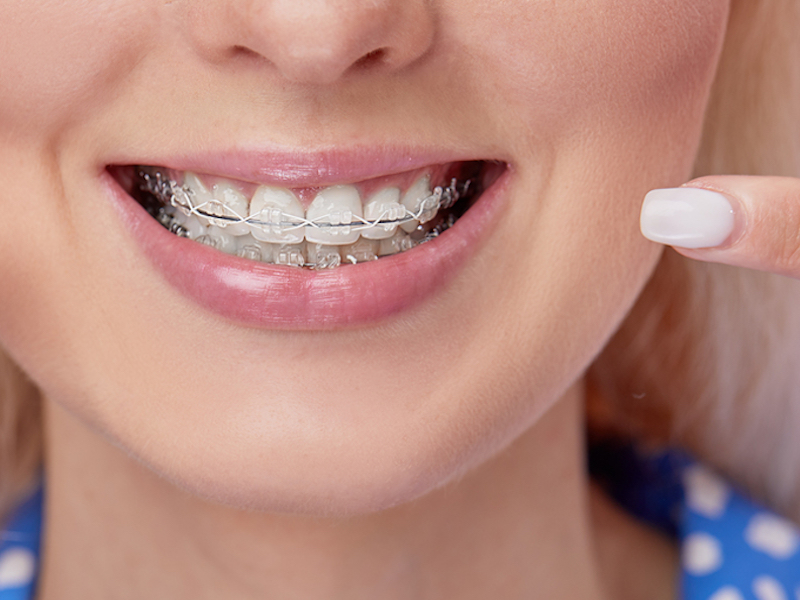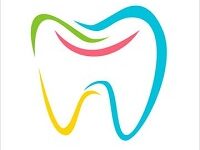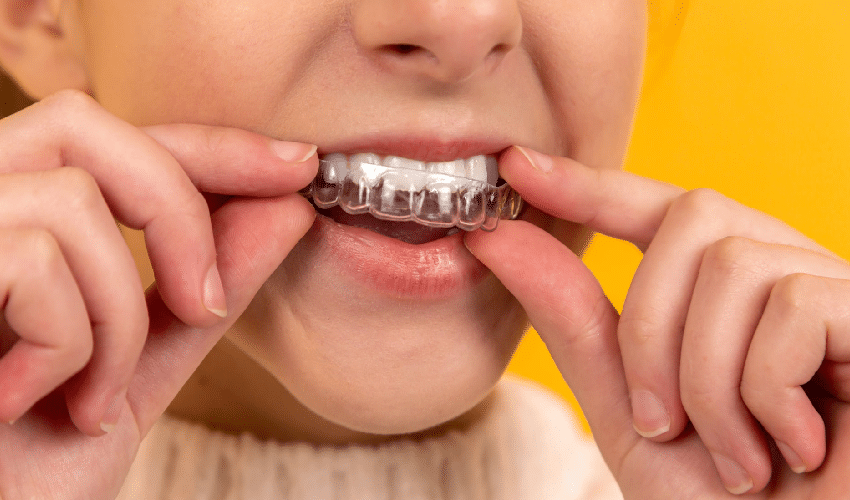The Latest Innovations in Orthodontic Braces
They say necessity is the mother of invention, and when it comes to orthodontic braces, this adage couldn’t be truer. Over the years, numerous innovations have emerged to make the journey towards a straighter smile more comfortable and efficient.
From self-ligating braces that eliminate the need for traditional elastic bands to clear aligners that discreetly straighten teeth, the field of orthodontics has seen remarkable advancements.
But what are the latest innovations in this ever-evolving realm? How do 3D printing technology and smart braces revolutionize the way we approach orthodontic treatment?
Join us as we explore these cutting-edge developments and discover how they are transforming the world of braces.
Self-ligating Braces
Self-ligating braces offer a more convenient and efficient orthodontic treatment option for those seeking straighter teeth. With traditional braces, metal or elastic ligatures are used to hold the archwire in place. This requires frequent adjustments and visits to the orthodontist to tighten the ligatures.
However, self-ligating braces have a built-in mechanism that eliminates the need for ligatures. Instead, they use a sliding mechanism to hold the wire in place, allowing for easier adjustments and fewer visits to the orthodontist.
The benefits of self-ligating braces go beyond convenience. These braces can reduce treatment time by exerting a more consistent and gentle force on the teeth, resulting in faster tooth movement. Additionally, self-ligating braces are easier to keep clean compared to traditional braces. The absence of ligatures means there are fewer nooks and crannies for food particles to get trapped, reducing the risk of plaque buildup and tooth decay.
Self-ligating braces come in both metal and ceramic options, allowing patients to choose the material that best suits their preferences. While self-ligating braces may be slightly more expensive than traditional braces, many patients find the added convenience and efficiency well worth the investment.
Clear Aligners
Clear aligners are a popular alternative to traditional braces for achieving straighter teeth. These innovative orthodontic devices are made of clear, BPA-free plastic and are custom-designed to fit over your teeth. They work by gradually shifting your teeth into the desired position using a series of removable trays. Clear aligners are virtually invisible, making them a discreet option for those who are self-conscious about wearing braces.
One of the key advantages of clear aligners is that they’re removable, allowing you to eat, drink, brush, and floss without any restrictions. This means you can still enjoy your favorite foods and maintain good oral hygiene throughout your orthodontic treatment. Clear aligners are also more comfortable than traditional braces, as they don’t have any metal brackets or wires that can cause discomfort or irritation.
Another benefit of clear aligners is that they require fewer visits to the orthodontist compared to traditional braces. Instead of having to visit the orthodontist every few weeks for adjustments, you’ll receive a set of aligners to wear for a specific period of time before moving on to the next set. This makes clear aligners a convenient option for those with busy schedules.
Lingual Braces
If you’re looking for an alternative to clear aligners, consider trying lingual braces. Lingual braces are a discreet and effective option for straightening your teeth. Unlike traditional braces that are placed on the front of your teeth, lingual braces are placed on the back of your teeth, making them virtually invisible to others. This makes them a popular choice for adults and teenagers who want to improve their smile without drawing attention to their orthodontic treatment.
One of the main advantages of lingual braces is their ability to correct a wide range of orthodontic issues. Whether you have crowded teeth, gaps, or a misaligned bite, lingual braces can help to address these concerns and give you a straighter smile. The brackets and wires used in lingual braces are custom-made to fit the contours of your teeth, ensuring a comfortable and precise fit.
Another benefit of lingual braces is that they’re suitable for almost everyone. Whether you have mild or severe orthodontic problems, lingual braces can be customized to meet your specific needs. They’re also a great option for those who play wind instruments or participate in contact sports, as the brackets are less likely to interfere with these activities.
In terms of treatment duration, lingual braces can achieve results in a similar timeframe to traditional braces. However, it’s important to note that the length of treatment will vary depending on the complexity of your case.
Ceramic Braces
Ceramic braces offer a discreet and effective alternative to traditional metal braces. Made from a translucent material, ceramic braces blend in with your natural teeth, making them much less noticeable than their metal counterparts. If you want to straighten your teeth but are concerned about the appearance of traditional braces, ceramic braces may be the perfect solution for you.
One of the main advantages of ceramic braces is their aesthetic appeal. The ceramic material used is designed to match the color of your teeth, making them much less noticeable. This is especially beneficial for adults and older teenagers who may feel self-conscious about wearing braces.
In addition to their discreet appearance, ceramic braces also provide effective orthodontic treatment. They work in the same way as traditional braces, using brackets and wires to gradually move your teeth into their desired positions. The only difference is the material used, which is more resistant to staining and discoloration than metal.
While ceramic braces are a great alternative to traditional metal braces, it’s important to keep in mind that they do require extra care. The ceramic material is more fragile than metal, so you’ll need to be careful when eating hard or sticky foods. Additionally, regular cleaning and maintenance are essential to prevent staining.
Accelerated Orthodontics
Accelerated orthodontics offers a way to speed up your treatment and reduce the overall treatment time. By using advanced techniques and technologies, orthodontists are able to achieve quicker results without compromising on quality.
With accelerated orthodontics, you can expect to see improvements in your smile in a shorter period of time.
Speeding up Treatment
To speed up your orthodontic treatment, there are innovations in accelerated orthodontics that can help improve the efficiency and effectiveness of braces. These advancements are designed to reduce the overall treatment time and provide you with a straighter smile in a shorter period.
One such innovation is the use of high-frequency vibration devices. These devices, when used in conjunction with braces, help to stimulate the bone remodeling process, allowing your teeth to move more quickly into their desired positions.
Another technique used in accelerated orthodontics is micro-osteoperforations. This involves creating tiny holes in the bone surrounding your teeth, which helps to stimulate the bone turnover and speeds up tooth movement.
Reduced Treatment Time
By incorporating accelerated orthodontics techniques, you can significantly reduce the treatment time for braces. Traditional orthodontic treatment can take several years, but with the latest innovations, you now have options to expedite the process.
One such technique is called Wilckodontics, which involves performing a minor surgical procedure to stimulate bone remodeling. This allows for faster tooth movement and can reduce the treatment time by up to 50%.
Another method is the use of high-frequency vibration devices, which help to accelerate tooth movement. These devices apply gentle vibrations to the braces, increasing the rate at which the teeth shift into their desired positions.
Additionally, advancements in technology have led to the development of self-ligating braces, which eliminate the need for elastic or metal ligatures. This reduces friction and allows for more efficient tooth movement.
With these accelerated orthodontic techniques, you can achieve a straighter smile in a shorter amount of time.
3D Printing Technology
With the advancements in orthodontic technology, the integration of 3D printing has revolutionized the field of braces. This innovative technology allows for the creation of customized orthodontic appliances with greater precision and efficiency. Traditional braces are typically made using molds and manual adjustments, which can be time-consuming and less accurate. However, with 3D printing, orthodontists can now create braces that perfectly fit the patient’s teeth, resulting in a more comfortable and effective treatment.
One of the key benefits of 3D printing technology is its ability to streamline the manufacturing process. Using digital scans of the patient’s teeth, orthodontists can design and produce braces with intricate details that were previously difficult to achieve. The use of 3D printing also allows for the production of braces with lightweight and durable materials, improving patient comfort and reducing the risk of breakage.
Moreover, 3D printing technology enables orthodontists to create aligners that are virtually invisible, such as clear aligners. These aligners are custom-made to gradually move the patient’s teeth into proper alignment. They’re removable, allowing for easy cleaning and maintenance. This technology has greatly expanded the options for orthodontic treatment, providing patients with more discreet and comfortable alternatives to traditional braces.
Smart Braces
As technology continues to advance in the field of orthodontics, the next breakthrough in braces comes in the form of smart braces, introducing a new level of functionality and convenience. Smart braces incorporate advanced technology to provide a more efficient and personalized orthodontic treatment experience.
One of the main features of smart braces is their ability to monitor and track your progress in real-time. Using sensors and wireless connectivity, these braces collect data about your tooth movement and transmit it to a mobile app or a computer. This allows your orthodontist to remotely monitor your progress and make necessary adjustments without the need for frequent in-person appointments.
Smart braces also come equipped with smartwires, which are wires that can adjust themselves based on the information received from the sensors. This means that the braces can automatically make small adjustments to the wire tension, guiding your teeth into the desired position more efficiently.
Another advantage of smart braces is their ability to provide personalized treatment plans. The collected data allows orthodontists to create customized treatment plans tailored specifically to your needs. This ensures that your treatment is optimized for the best results in the shortest amount of time.
In addition to these features, smart braces also offer enhanced comfort and convenience. With their advanced technology, smart braces are designed to be more discreet and less bulky than traditional braces, making them more comfortable to wear. They also eliminate the need for manual wire adjustments, reducing discomfort and saving time.
Frequently Asked Questions
Are Self-Ligating Braces More Expensive Than Traditional Braces?
Self-ligating braces may be more expensive than traditional braces. This is because self-ligating braces are a newer innovation in orthodontics and often come with additional features and benefits. These braces use special brackets that don’t require elastic bands to hold the wires in place, resulting in less friction and discomfort.
While self-ligating braces may cost more upfront, they can potentially lead to shorter treatment times and fewer visits to the orthodontist. Ultimately, the cost will depend on various factors, including the specific orthodontic practice and the individual treatment needs.
Can Clear Aligners Be Used to Treat Severe Orthodontic Issues?
Clear aligners can be used to treat severe orthodontic issues. They’re a popular choice for those who want a discreet and convenient option to straighten their teeth. While they may not be suitable for all cases, clear aligners have been proven effective in treating a wide range of orthodontic problems.
Your orthodontist will assess your specific needs and determine if clear aligners are the right choice for you.
How Long Does It Take to Get Used to Speaking With Lingual Braces?
It typically takes a few weeks to get used to speaking with lingual braces. At first, you may experience some difficulty pronouncing certain sounds or speaking clearly.
However, with practice and patience, your speech will gradually improve. It’s important to remember that everyone adjusts at their own pace, so don’t get discouraged if it takes a bit longer for you.
Your orthodontist will be there to support you throughout the process.
Are Ceramic Braces as Durable as Metal Braces?
Ceramic braces are a popular choice for those who want a more discreet option. They’re designed to blend in with your natural tooth color, making them less noticeable than metal braces.
However, when it comes to durability, ceramic braces may not be as strong as metal braces. They’re more prone to cracking or breaking, especially if you don’t take proper care of them.
It’s important to follow your orthodontist’s instructions to ensure the longevity of your ceramic braces.
Can Accelerated Orthodontics Be Used on Patients of All Ages?
Accelerated orthodontics, a technique that speeds up the teeth straightening process, can indeed be used on patients of all ages. This innovative method involves applying gentle pressure to move the teeth into their desired positions more quickly than traditional braces.
By using advanced technology and materials, orthodontists can offer this option to patients who want to achieve a straighter smile in a shorter amount of time.
Conclusion
In conclusion, the latest innovations in orthodontic braces have revolutionized the field of orthodontics.
Self-ligating braces, clear aligners, lingual braces, ceramic braces, accelerated orthodontics, 3D printing technology, and smart braces have all contributed to more efficient and comfortable treatment options for patients.

These advancements have made orthodontic treatment more accessible and convenient, allowing individuals to achieve their desired smile with less discomfort and shorter treatment times.

Welcome to my website! My name is Christopher Boake, and I am a dedicated and passionate dental hygienist with years of experience in the field. I am thrilled to share my knowledge and expertise with you through this platform, where I aim to provide valuable information on everyday dental care tips, restorative dental innovations, cosmetic smile enhancements, and periodontal treatment and maintenance.

